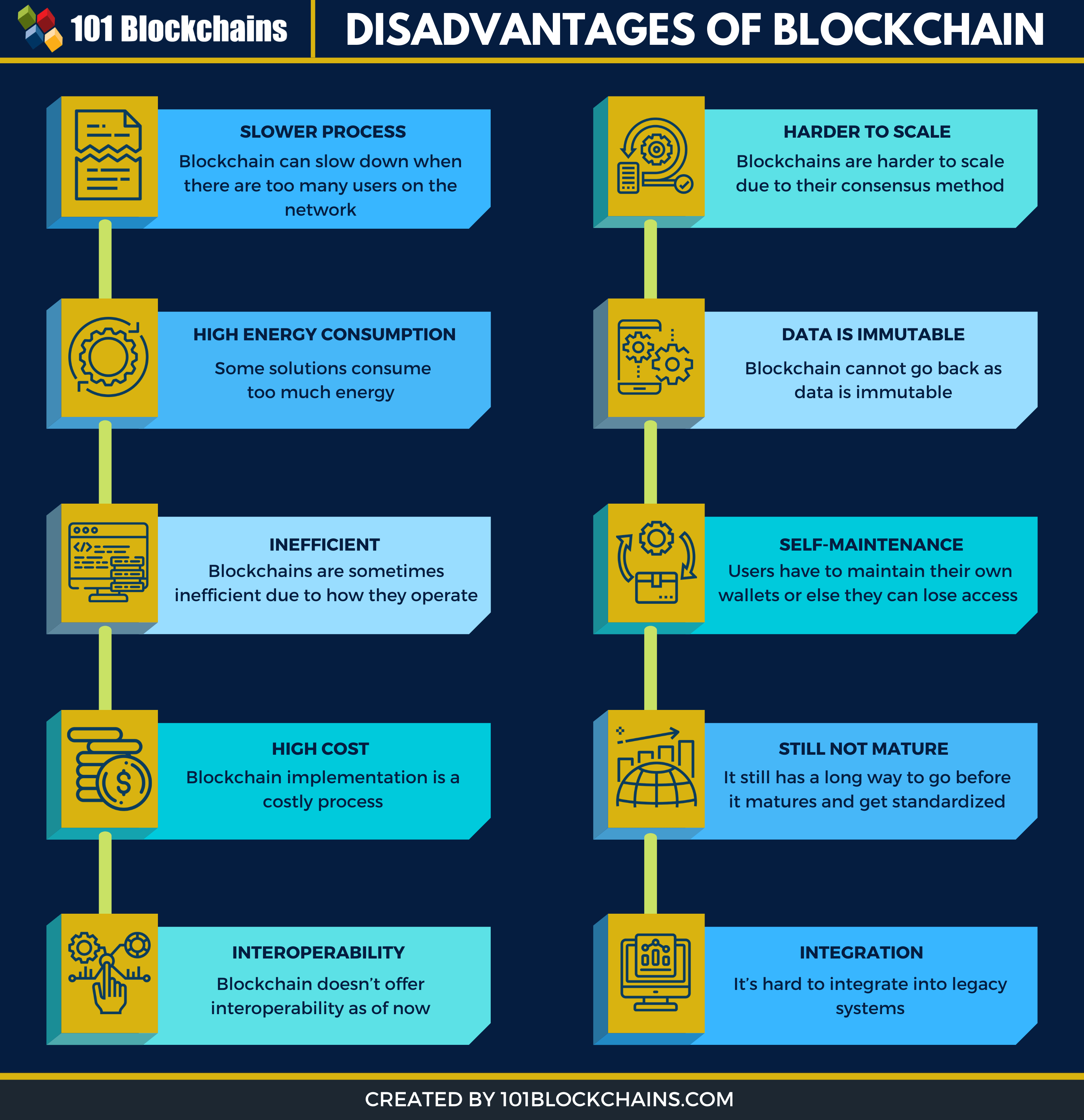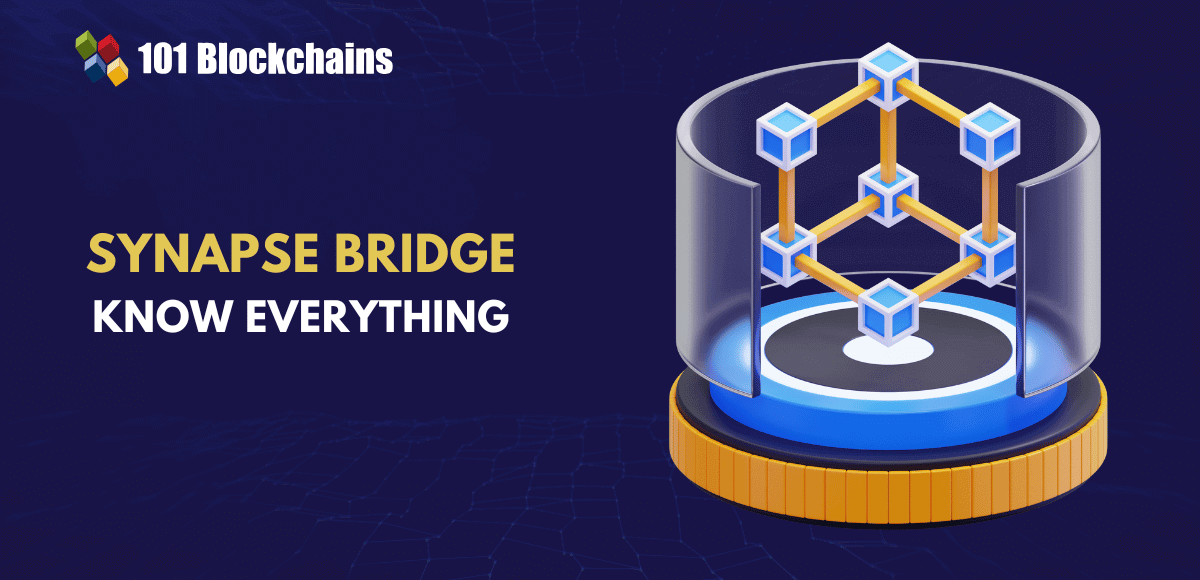Learn how blockchain truly works, master key definitions, and uncover what makes smart contracts so "smart." Dive into the fundamentals, gain valuable insights, and start your blockchain journey today!

- Blockchain
Gwyneth Iredale
- on April 17, 2020
Top Disadvantages of Blockchain Technology
Do you want to know about the disadvantages of blockchain technology? If yes, you have come to the right place. Let’s dive in!
If you are following the blockchain technology landscape, then you will see a trend of positive articles and information about blockchain. Almost every publication is selling the term to drive blockchain adoption among enterprise users, learners, and developers.
However, that’s only the half side of blockchain technology. Just like any other technology, it does come with its own drawbacks, i.e., disadvantages.
The trends also speak for themselves. Companies are looking for blockchain talent as their demands soar.
In this article, we will explore those disadvantages and understand blockchain technology in a much better way.
If you are reading the article, you already know the advantages of blockchain. It is immutable, transparent, secure, and decentralized. The features are revolutionary for sure as they can be used for multiple use cases and industries.
But, to make sure that we all are on the same page, let me start with a very basic definition of blockchain.
Build your identity as a certified blockchain expert with 101 Blockchains’ Blockchain Certifications designed to provide enhanced career prospects.
What is Blockchain?
Blockchain is a distributed ledger technology that improves centralized-based solutions in different ways. It consists of peers connected in a distributed network where each peer has a copy of the ledger. To validate the transactions between those peers, the network utilizes a consensus algorithm.
Sounds complicated? Let’s try to simplify it below.
Let’s take three people. Each of these people is an individual with their own identity. While each individual is capable of working on their own, they need a centralized authority when doing transactions between them. For example, if one tries to send money to another, it will have to go through a centralized bank or payment gateway.
Now, in the case of a decentralized network, if John tries to send money to Alice, they can do it by themselves without relying on a centralized entity. Here, each of the individual people acts as their own bank. They do not have to rely on a centralized entity to complete the transaction and that itself opens up a wide range of use cases.
If you want to learn more, then you should check out our detailed beginner’s guide on blockchain: Blockchain For Beginners: Getting Started Guide
Let’s learn about the disadvantages of blockchain technology.
Start learning Blockchain with the world’s first Blockchain Expert Career Path and become a Blockchain Expert!
What are the Disadvantages of Blockchain Technology?
Blockchain technology is going to change the world around us. However, to understand what it has to offer, we need to understand its disadvantages as well. In this section, we will go through all the points below.
Please include attribution to 101blockchains.com with this graphic. <a href='https://101blockchains.com/blockchain-infographics/'> <img src='https://101blockchains.com/wp-content/uploads/2020/04/Disadvantages-of-Blockchain-.png' alt='Disadvantages of Blockchain='0' /> </a>
Watch This Video To Know About Top Disadvantages of Blockchain Right Now!
1. Blockchain is not a Distributed Computing System
Blockchain is a network that relies on nodes to function properly. The quality of the nodes determines the quality of the blockchain. For example, Bitcoin’s blockchain is strong and incentivizes the nodes to participate in the network. However, the same cannot be true for a blockchain network that does not incentivize the nodes.
This means that it is not a distributed computing system where the network doesn’t depend on the involvement and participation of the nodes. In comparison, a distributed computing system works to ensure that they verify the transactions according to the rules, ensure that they record the transactions, and also make sure that they have the transactional history for each transaction. Each of these actions is similar to that of blockchain, but there is a lack of synergy, mutual assistance, and paralleling for each one of them.
Clearly, blockchain might be a distributed network, but it lacks the features that make a distributed computing system so beneficial for corporations.
Read More: List of Top 50 Companies Using Blockchain Technology
2. Scalability Is An Issue
Blockchains are not scalable as their counterpart centralized systems. If you have used the Bitcoin network, then you would know that the transactions are completed depending on the network congestion. This problem is related to scalability issues with blockchain networks. In simple words, the more people or nodes join the network, the chances of slowing down is more!
However, there has been an increasing change in how blockchain technology works. With the right evolution of the technology, scalability options are being integrated with the Bitcoin network as well. The solution is to do transactions off-blockchain and only use blockchain to store and access information.
Other than that, there are also new ways of solving scalability, including permissioned networks or using a different architectural blockchain solution such as Corda.
However, all these solutions are still not on par with the centralized systems. If you compare Bitcoin and VISA transaction speeds, you will find a huge difference between them. Right now, Bitcoin can only do 4.6 transactions per second. In comparison, VISA can do a whooping 1700 transactions per second. This means that in a day, it can do 150 million transactions per second.
Lastly, we can say that blockchain might not be still well-equipped for real-world applications. It still needs significant improvement before it can be adopted in day-to-day life.
3. Some Blockchain Solutions Consume Too Much Energy
Blockchain technology got introduced with Bitcoin. It uses the Proof-of-Work consensus algorithm that relied on the miners to do the hard work. The miners are incentivized to solve complex mathematical problems. The high energy consumption is what makes these complex mathematical problems not so ideal for the real world.
Every time the ledger is updated with a new transaction, the miners need to solve the problems which means spending a lot of energy. However, not all blockchain solutions work in the same manner. There are other consensus algorithms that have solved the problem. For example, permissioned or private networks do not have these problems as the number of nodes within the network is limited. Also, as there is no need for global consensus, they use efficient consensus methods to reach consensus.
But, if you take the most popular blockchain network, Bitcoin, the problem still persists that needs to be solved.
In short, permissioned networks are efficient when it comes to energy consumption whereas public networks can consume a lot of energy to remain operational.
Also Read: PoW Vs. PoS: A Comparison Between Two Blockchain Consensus Algorithms
4. Blockchain Cannot Go Back — Data is Immutable
Data immutability has always been one of the biggest disadvantages of the blockchain. It is clear that multiple systems benefit from it including supply chain, financial systems, and so on. However, if you take how networks work, you should understand that this immutability can only be present if the network nodes are distributed fairly.
What I mean to say is that a blockchain network can be controlled by an entity if it owns 50% or more of the nodes making it vulnerable.
Another problem that it suffers from is the data once written cannot be removed. Every person on the earth has the right to privacy. However, if the same person utilizes a digital platform that runs on blockchain technology, then he will be unable to remove its trace from the system when he doesn’t want it there. In simple words, there is no way, he can remove his trace, leaving privacy rights into pieces.
5. Blockchains are Sometimes Inefficient
Right now, there are multiple blockchain technologies out there. If you pick up the most popular ones including the blockchain technology used by Bitcoin, you will find a lot of inefficiencies within the system. This is one of the big disadvantages of blockchain.
First of all, when I tried to set up the Bitcoin miner on my system, I quickly found out that the ledger can easily cross hundreds of GBs. It was not efficient in data storage which can lead to storage problems for multiple nodes that want to become part of the network.
Clearly, there needs to be a better way to handle this as whenever the data is updated, nodes need to replicate it. Moreover, the size of the blockchain grows with more transactions and nodes. If it continues to grow, then the whole network is slowed down. This is not ideal for commercial blockchains where it is essential for the network to be fast and secure at the same time.
Slowly inefficiencies are being improved with the help of other blockchain solutions. Bitcoin is also trying to solve inefficiencies with the help of lightning networks.
Enroll Now: Free Blockchain Fundamentals Course
6. Not Completely Secure
Blockchain technology is more secure than other platforms. However, this doesn’t mean that it is not completely secure. There are different ways the blockchain network can be compromised. Let’s go through them below one by one to make more sense out of it.
- 51% attack: In the 51% attack, if an entity can control 51% or more of the network nodes, then it can result in control of the network. By doing so, they can modify the data in the ledger and also do double-spending. This is possible on networks where the control of miners or nodes is possible. This means that private networks are more likely to be safe from 51% of attacks, whereas public ones are more vulnerable to this.
- Double-spending: Double-spending is yet another problem with the current blockchain technology. To prevent double-spending the blockchain network deploys different consensus algorithms including Proof-of-Stake, Proof-of-Work, and so on. Double spending is only possible on networks with a vulnerability to the 51% attack.
- DDoS attack: In a DDoS attack, the nodes are bombarded with similar requests, congesting the network and bringing it down.
- Cryptographic cracking: Another way the blockchain technology is not secure is the cryptographic solution that it utilizes. Quantum algorithms or computing are more than capable of breaking cryptographic cracking. However, blockchain solutions are now implementing quantum-proof cryptographic algorithms.
7. Users Are Their Own Bank: Private Keys
To make blockchain decentralized, it is important to give individuals the ability to act as their own bank. However, this also leads to another problem.
To access the assets or the information stored by the user in the blockchain, they need private keys. It is generated during the wallet creation process, and it is the responsibility of the user to take proper note of it. They also need to make sure that they do not share it with anyone else. If they fail to do so, their wallet is in danger. Also, if they lose the private key, they will lose access to the wallet forever. The reliance on users makes it one of the disadvantages of blockchain.
So, if you as a user who forgets your private key, are eventually logged out of your wallet and no one can get it back. This is a serious drawback as not all users are tech-savvy and have more chances to make mistakes. If there is a centralized authority that takes care of it, then it defeats the purpose of decentralization.
Read More: Newbie’s Guide: Private Key Vs Public Key – How They Work?
8. Cost And Implementation Struggle
The underlying cost of implementing blockchain technology is huge. Even though most of the blockchain solutions including Hyperledger are open source, they require a lot of investment from the organization that is willing to pursue it.
There are costs associated with hiring developers, managing a team that excels at different aspects of blockchain technology, licensing costs if you opt for a paid blockchain solution, and so on.
You also need to take care of the maintenance cost associated with the solution. For enterprise blockchain projects, the cost can go over a million dollars as well.
So businesses who like the idea of blockchain, but do not have the funds or budget to carry it out, might need to wait more before they can jump into the blockchain bandwagon.
Not sure how to build a career in enterprise blockchains? Enroll Now: How to Build Your Career in Enterprise Blockchains
9. Expertise Knowledge
Implementing and managing a blockchain project is hard. It requires thorough knowledge from the business to go through the whole process.
They need to hire multiple experts in the blockchain field which leads to the problem and hence it is counted as one of the disadvantages of blockchain.
Not only that they also need to train their existing professionals on how to utilize blockchain and then ensure that the management team can understand the complexities and outcomes of a blockchain-powered business.
This way, they can understand their requirements and help transform their business processes to utilize blockchain.
Not to mention, if you find blockchain developers and specialists, they are harder to find and will cost more compared to traditional developers due to their demand and supply ratio.
If you are eager to learn about Blockchain use cases then you can check out the articles listed below.
10. Maturity
Blockchain technology is only a decade old. This means that it is a new technology that requires time to mature. If you take the different consortiums into account, you will notice multiple players trying to solve the decentralized problem with their unique solutions.
For example, we have Corda, Hyperledger, Enterprise Ethereum, Ripple, and so on! All-in-all, there is still a lot of time left before blockchain technology matures and businesses will have less hesitation to adopt blockchain technology.
Like any other new technology, maturity is another problem that blockchain has to solve, and hence it is one of the disadvantages of blockchain.
Blockchains are also not getting matured for a long time for now. There is still a lot to go before we can see changes in standardizing blockchain technology. Right now, there are too diverse solutions that aim to solve the core problems but are not working together to standardize them.
11. Interoperability
Another disadvantage that blockchain technology suffers from is interoperability. As mentioned in the last point, there are multiple types of blockchain networks that work differently, trying to solve the DLT problem in their own unique way. This leads to interoperability issues where these chains are not able to communicate effectively.
The interoperability issue also persists when it comes to traditional systems and systems using blockchain technology.
12. Legacy Systems
Not all businesses have changed from legacy systems. There are still many organizations that rely on legacy systems to run their business. However, if they want to adopt blockchain technology, they need to completely get rid of their systems and change to blockchain technology — which is not feasible for every business out there.
Get familiar with the terms related to blockchain with Blockchain Basics Flashcards.
Conclusion
This leads us to the end of our disadvantages of blockchain technology. There is no doubt that blockchain technology has its own cons and all the points that we discussed above.
There are newer blockchain solutions that offer better solutions compared to the first generation of blockchain technology. For example, Ethereum solved the inefficiencies by shifting to a better blockchain technology solution where there is a way of automation using smart contracts. It also adopted Proof-of-Stake (PoS) which is somewhat more efficient than that of Proof-of-Work (PoW).
We also have Hyperledger – an open-source initiative by The Linux Foundation trying to unify blockchain solutions under one big umbrella. This will improve the way how enterprises adopt blockchain technology including frameworks, tools, APIs, and so on.
So, what do you think about them? Comment below and let us know.
If you’re aspiring to start a career in Blockchain, we’ve brought a Free Blockchain Fundamentals Course for you. Enroll now and start your blockchain journey today!







